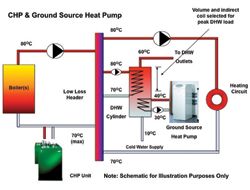It is crucial to share knowledge and expertise as early as possible when embarking upon low carbon commercial heating projects, says Jeff House
In the UK, architects, developers, system design engineers, contractors and end users are increasingly considering the use of low and zero carbon (LZC) products and solutions in both communally heated residential schemes and the commercial property sector.
The primary drivers have been the introduction of increasingly stringent legislation since the Kyoto Protocol to achieve a 20 per cent reduction in carbon emissions (compared with 1999) and generating 20 per cent of energy from renewable technologies both by 2020 and an 80 per cent reduction in carbon emissions by 2050.
Impetus is being maintained through changes to Part L of the Building Regulations and the introduction of specific codes and standards, corporate environmental policies and local authority planning consent requirements. Other UK Government measures are the Carbon Reduction Commitment and Renewable Heat Incentive.
There is also impending EU legislation in the form of the ERP (Energy Related Products) Directive, relating to system efficiency rather than product efficiency, all of which will have a far-reaching impact in the UK building services industry.
Product combination
In order to meet the demand to achieve zero carbon homes and non-residential buildings, commercial heating and hot water systems will inevitably need to include a combination of conventional products such as boilers, direct-fired water heaters and calorifiers together with more innovative LZC technologies. Those being most widely adopted, for example, solar thermal, air, gas absorption and ground source heat pumps and combined heat and power (CHP) units, are well proven in other countries and are now widely available here in the UK.
These LZC technologies can be integrated with conventional high efficiency heating equipment and offer operational longevity. Already successfully used in schools, university buildings, fire service depots, offices, hotels, residential care homes and multi-occupancy accommodation such as sheltered housing, social housing developments and key work schemes, they will have a sustained position within the H&V landscape for many years to come.

The correct marriage of technologies is the over-riding consideration in any commercial heating system that uses a combination of conventional high efficiency and LZC solutions. The number of heat sources now being deployed in plant rooms to deliver the carbon savings demanded by local authorities and the underpinning legislation has resulted in hydraulic schematics becoming more complicated. This means that knowledgeable, reliable and early application support are vital from equipment manufacturers able to provide sound technical advice specific to the application with detailed and high quality documentation.
The most effective implementation measure has been the local authority planning consent requirement for 10 to 15 per cent of the energy used by commercial buildings to be derived from some form of LZC solution. For some projects there are also BREEAM (Building Research Establishment Environ-mental Assessment Methodology) ratings to consider.
An integrated system is the way forward, but an accurate load assessment for the building is essential for the correct mix of technologies to be selected.
For instance, if DHW is the dominant load, separation from the space heating load with hot water generation via a solar thermal system, linked to primary heat source such as condensing direct gas-fired storage water heaters, could be the most effective solution. However, if the building is unoccupied during the months of highest solar gain, or if there is insufficient space or suitable location for the solar arrays, heat pumps may offer a more appropriate solution.
With products and solutions that generate heat, there is a much greater chance of operational conflict due to the available heat load, whether space heating or hot water. (The exception may perhaps be those properties connected to a district heating system.)
For instance, while the combination of solar thermal solutions and CHP units can work well in the correct application and with suitable selected equipment outputs, in the absence of sufficient thermal load may lead to operational issues and a compromise on the building's carbon footprint.
CHP units are heat-led devices. If a solar thermal solution is satisfying the daily hot water demand during the summer months, there is no hot water load to offer the CHP unit when there is also no heating load. Therefore, the solar thermal system would hold off the CHP unit, reducing the annual operating hours having implications on the economic and environmental benefits of the installation. Only if there is sufficient base thermal load to support the operation of the CHP unit and the solar collector array during the summer months can the marriage of these two technologies deliver cumulative carbon dioxide savings.
De-carbonising energy input
Ground source heat pumps used alongside CHP units can work well together in providing a potentially ultra-low carbon solution, provided there is sufficient base thermal load to support the operation of both these heat sources. Under normal operating conditions, the electricity generated by the CHP unit could be used to power the heat pump, effectively 'de-carbonising' its energy input and thereby having a significant impact on the carbon footprint of the installation.
Any UK heating manufacturer that can truly claim to be a 'one stop shop' heating solutions provider will be able to take all these and other relevant factors into account. In addition to this and the ability to offer back-up as early as possible in the project planning stage right through to set up and commissioning, it is now even possible to take up the additional option of a service contract on all boiler house equipment - both new and existing.